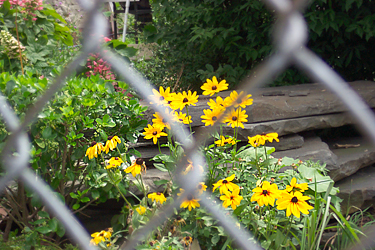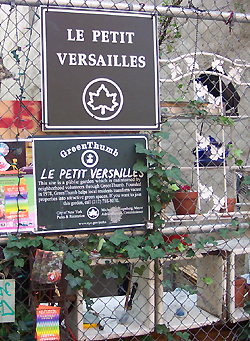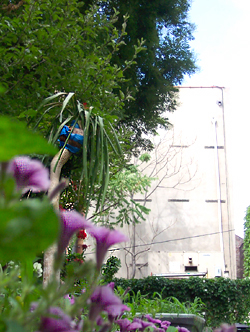
Prospect Heights Community Farm, Brooklyn
On a sunny spring Saturday, three boys fashioned a small rock garden at the Walt L. Shamel Community Garden in Bedford-Stuyvesant. Two older teenagers, Joevanni and Antonio, shoveled topsoil into wheelbarrows and ferried it to the back of the garden where they spread it out to make new planting beds. Rodney Duncan and Gregory Anderson, residents who are leading the effort to upgrade the garden and create a big community backyard, watched the young people work.
“One of the things we wanted was for children and seniors to get involved,” Anderson said. “You can’t have a better activity than this for children.”
Like most of the community gardens throughout the city, the Walt L. Shamel garden was reclaimed from a vacant city-owned lot in a poor neighborhood devastated by arson, crime, and abandonment. More than 20 years ago, residents around the city chased out drug dealers, cleared the rubble, and created green and safe spaces as diverse as their communities. Then, under Mayor Rudolph Giuliani, the city began the wholesale auctioning of the gardens – leading to fears that many of these community spaces would vanish in a city where almost every dispute comes down to a fight for space.
But today Duncan, Anderson and others can make big plans for their space because of a 2002 compromise that protected their garden and many others.
For the majority of gardeners, life has gotten a lot sweeter since the days when Mayor Giuliani seemed determined to wipe them out along with the squeegee men. But some gardens, especially in Harlem, remain threatened. “There’s a general sense that the struggle is over, but that’s really not true,” said Hannah Risely-White, the lead organizer at the Green Guerillas, which has been working with grassroots groups to create gardens for more than 30 years.
Four years after the agreement, what is the state of the city's community gardens?
OUT OF THE RUBBLE
As New York’s economy declined in the 1970s, arson and neglect left entire neighborhoods pocked with vacant lots, which became magnets for trash and drug dealers. The city seized a number of these lots because their owners had failed to pay the property taxes. Residents began to clean them up the land and plant gardens. The city allowed them to use the space with the understanding that it would someday reclaim the land. But the gardens came to serve an important function in their communities, many of which had few parks or other open spaces.
In the late 1990s, with the city on the rebound and real estate values rising, the Giuliani administration began taking steps to sell off many of the gardens. The mayor said that, in a city with homelessness and an acute shortage of housing, the land could be put to better use providing homes.
The gardeners countered that the city had many other vacant lots to develop for housing. They spoke of the role the gardens played in their neighborhoods in providing much-needed green space, creating a sense of community, educating children, and even growing food for low-income residents. The move to shut down the gardens sparked protests from gardeners and outcries from many quarters; the New York Times called the sale of the green spaces "an act of neighborhood violence."
In 1999, two non-profits, The Trust for Public Land and the New York Restoration Project, saved more than 100 gardens by purchasing them to be held in independent land trusts.
But several hundred more gardens remained threatened. Attorney General Eliot Spitzer, who recently told a gathering of gardeners that someone dressed as a sunflower first brought the issue to his attention, filed suit to block the destruction of the gardens.
In 2002, after Giuliani departed from City Hall, Spitzer and newly elected Mayor Michael Bloomberg settled the lawsuit. Their agreement protected 198 gardens outright and required a full public review of proposals to build on 114 gardens where development was to be allowed. Thirty-eight gardens that had already undergone a review were released for immediate development.
FRUITS OF THE SETTLEMENT
|
Community Garden on East 2nd Street |
Nearly four years later, the numbers look a little different as the review process has unfolded. Some of the gardens originally slated for development have been moved to new locations or saved as development projects made space for gardening.
The Department of Housing Preservation and Development, which has jurisdiction over nearly all of the gardens subject to development, works with developers to meet the city’s goals of creating more low and middle income housing on those sites. Some of the projects also include retail and community services. But in an unexpected turn of events, the department has been working closely with the parks department to preserve active gardens whenever possible by swapping them with sites on the protected list that never were gardened or are no longer being used by the community.
So far, just 45 former gardens have been lost, including the 38 on the immediate development list. Many of these sites now hold affordable housing or community facilities, fulfilling needs even the bereft gardeners concede are important. About 50 active gardens, though, still must undergo the review process and are likely to be developed.
THE PROTECTED GARDENS
All of the 198 gardens permanently preserved under the agreement have been transferred to the city Department of Parks and Recreation. Including the gardens that were already under parks jurisdiction, that brings the total number of parks department community gardens to around 300. Parks officials say that as long as these spaces continue to function as community gardens, they will have all the safeguards of parkland, which cannot be taken for another use without approval by the State Legislature.
“They’re as protected as the gardens are active,” said Deputy Commissioner Jack Linn. “That’s the ultimate bottom line of the compact between the city and the gardeners.”
Park status provides a number of other benefits as well. Through the city’s urban gardening program, Greenthumb, the department has made major improvements to its newly acquired gardens, providing new fences and fixing hazards like broken sidewalks and dead trees. Greenthumb, which is federally funded, also gives topsoil, plants, and assistance to every site, whether it is officially a park or not, that meets its requirements: being open 10 hours a week and having at least 10 members. Director Edie Stone estimates there are about 500 Greenthumb gardens, including some slated for eventual development, in land trusts, under the jurisdiction of other city agencies, and on school property.
All of the gardens on city-owned land, including those that may be eventually developed, have been released from their biggest burden, the requirement that they carry private liability insurance. Thirty years ago, the Neighborhood Open Space Coalition was founded to provide affordable insurance for the gardens, but as rates rose steeply, the nonprofit was no longer able to absorb the costs. As of this spring, the city has extended its insurance protection to all gardens registered with Greenthumb.
MORE GARDENS SAVED
Unlike during the Giuliani administration, the Department of Housing Preservation and Development understand the benefits of gardens and has worked with the parks department, developers, and the community to preserve a number that otherwise would have been developed.
Nineteen gardens were saved in exchange for 21 sites that were protected but not being used, according to Holly M. Leicht, assistant commissioner for the Division of Planning and Pipeline Development at the housing agency. Many of the gardens were in East New York, “where there were a number of really high quality gardens that looked like they were going to be destroyed,” she said. A final swap is in the works to save eight more gardens.
Several projects have also been redesigned to accommodate gardens, said Leicht. That includes the Melrose Commons urban renewal project in the South Bronx, where a compromise with two grassroots gardening groups, South Bronx United Gardeners and the, More Gardens! Coalition ended up preserving half of the acreage for gardening, although a number of gardens were moved.
“They have some really good people at HPD working really hard to save gardens when they can,” said Tom Congdon, a policy analyst who is the attorney general’s point person on the issue. “That’s a huge shift from when we first got involved in this issue in the late 1990s.”
Leicht, who used to be on the other side of the issue with the Municipal Art Society, says balancing demands for green space and affordable housing presents a constant challenge. “All the more I understand the importance of thinking of these spaces individually and finding the balance between the two needs, because they’re both great needs in all of the communities,” she said.
AN UNCERTAIN FUTURE
Some community gardeners wonder whether development pressure could threaten even those gardens under the parks department’s jurisdiction. “Parks will say, â€If you can keep it running to standards, it is protected. But that’s not the way official parkland works,” said Dave Lutz, director of the Neighborhood Open Space Coalition. “What’s going to happen when a developer looks at a garden and says, â€This property is superb. We can turn it into a 17-story apartment building and name it â€Once Was a Garden’? What elected official can resist a well-endowed developer?”
The question of how the city will handle that looms even larger for gardens still subject to development. Under the 2002 agreement, gardeners must be notified that there is a building proposal pending for their site, what the review process will be, and what, if any, alternative sites are being offered for the garden. If the gardeners don’t accept a new site (which can be up to half a mile away) or if no alternative is available, that information becomes part of the public review.
The process is meant to give gardeners a fighting chance to persuade the community board and local council member of the importance of their space. But given the imperfect nature of the city’s land use reviews — the most commonly used is the Uniform Land Use Review Process — gardeners have the best chance of success if they are savvy about the political process and act quickly when they receive notice that their garden is under review.
“We tell the gardeners all the time, when you get that initial letter saying your garden is subject to the following development, and we are offering you alternative sites, this is the notice to stay involved in the process,” said Congdon. “It is incumbent upon the gardeners to reach out to local council members and community board members” to present their case and make sure they have a presence at meetings and hearings.
In most cases the local community board and council member have final say. So far, very few projects at sites on the subject-to-development list have been rejected in favor of keeping a garden.
A number of gardens have moved to other sites, often on the same block, said Edie Stone of Greenthumb, although she couldn’t provide an exact count. And in other cases, gardeners from several sites have doubled up in one space.
The reviews of the remaining gardens are expected to be completed by the time the agreement expires in 2010.
STANDING THEIR GROUND
One third of those 50 gardens are in Harlem. The housing department says that it has no alternative sites there to offer gardeners as it faces pressures from the red-hot real estate market and the local community’s demand for more affordable housing. Almost all the other vacant lots in Harlem are privately owned.
|
Peachtree Garden in the East Village |
Alex Brown, one of the leaders of the Harlem United Gardeners, lost his garden on Eleventh Avenue two years ago. But he continues to fight on behalf of other gardens in Harlem.
Brown’s group seeks to make developers and Harlem’s City Council members more aware of the benefits of community gardens. Schools use them to teach students about plants and ecology, and residents grow fresh fruits and vegetables for themselves and local food programs. Brown believes gardens also help prevent crime: “Lots of youth who see what’s going on inside the gardens get some kind of appreciation for life and gardening, and how it can bring more peace in mind and body.”
“One of the most important things — and that’s what developers see — is the pride and beauty that community gardens bring,” he said.
A recent study by the New York University School of Law backs this up. It found that the creation of a community garden has a positive impact on nearby residential property values and is associated with a neighborhood’s economic revival.
The Harlem gardeners are currently focusing their efforts on the Nuevo Esperanza garden at 110th Street and Fifth Avenue, which is facing imminent development. Reprising the protests of the Giuliani era, members of the garden and the More Gardens! Coalition have been camping in the garden prepared to face down the bulldozers.
The garden was originally slated to be replaced by an Edison Company charter school, to be built in partnership with the Museum of African Arts. Edison planned to buy another site for the gardeners to use. But gardeners lost that option when the company backed out and the development was changed to a 40-story market-rate condominium building, which is helping to make the building of the museum possible.
The project has brought to the surface the resentment simmering in Harlem over race and class as skyrocketing real estate prices and gentrification squeeze out current residents. The protests have as much to do with the city providing a valuable piece of land to a well-connected developer for condos as it does to losing the garden.
“We want to see some plans that include the community and not just shoves them off because luxury housing is coming,” said Aresh Javadi, co-founder of More Gardens! “Without these gardens there never would have been this change of people wanting to live around here.”
“Gardeners are not against housing,” said Javadi. “They want housing and they want the green spaces to stay.”
CHANGING COMMUNITIES
But while Harlem may present the starkest example of the pressures of increasing real estate prices on community gardens, changes in communities throughout the city present challenges for the gardens – even those that have been saved.
Many of the people who stuck it out during the bad times and worked to improve their communities can’t afford to live in these neighborhoods anymore. Gardeners find that people who recently moved to an area may need to work two or more jobs just to afford their homes and don’t have the time or interest in gardening. “
Often new people coming into the neighborhood like having the gardens there but don’t actually want to garden,” said Risely-White of the Green Guerillas, one of the groups helping struggling gardens recruit new members.
Stone said, “What we’re working on right now is keeping gardens sustainable for many generations into the future. They’re permanent, so we have to make sure there is somebody to care for them forever.”
For More Information:
Rats to Roses, a Sierra Club documentary scheduled to air this summer, covers the New York City community garden controversies of the 1990s. It focuses particularly on the Lower East Side’s Esperanza garden, which was bulldozed just hours before the injunction was granted preventing the destruction of community gardens pending the resolution of a lawsuit by the state attorney general.
Â

